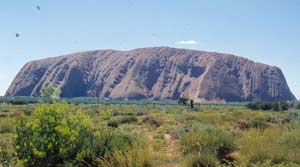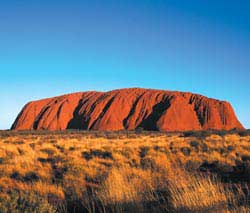 The enormous rock perched high on the wild plains of central Australia is a mountain, but it is a single monolith. Located south of the Macdonnell Ranges, it lies 350 kilometers east of the city of Alice Springs.
The enormous rock perched high on the wild plains of central Australia is a mountain, but it is a single monolith. Located south of the Macdonnell Ranges, it lies 350 kilometers east of the city of Alice Springs.
This largest monolith in the world stands 348 meters tall, stretches 3 kilometers in length, and has a base circumference of approximately 8.5 kilometers. With its steep cliffs on all four sides and a flat top resembling a newly cracked island, it appears like a gigantic beast resting on the ground, revealing a majestic, magnificent, and extraordinary sight. In 1973, European surveyor Kelispi Gauss visited this area and accidentally discovered this colossal rock. Initially, he thought it was merely an illusion and not real. After confirming that the marvelous scenery before him was indeed real, he was overjoyed and sought to climb to the summit. From there, he looked out across an unspoiled, dense expanse of wilderness that seemed endless.
To commemorate this unforgettable discovery, Gauss named the rock after the then Prime Minister of South Australia, Hengli Ayers. Subsequently, word of the giant rock spread far and wide, attracting visitors from all over. Today, this area has been developed into a national park and has become a famous tourist destination worldwide.
 From a distance, the exterior of Ayers Rock is round and smooth, a complete monolith with not a blade of grass. Visitors can capture unique images from various angles, depending on their imagination. However, what fascinates tourists the most is the stunning, ever-changing color of the giant rock. At dawn, as the sun rises, the entire rock takes on a light red hue. By midday, it transforms into an orange-red, reflecting the sunlight. In the afternoon, as the sun sets in the west, the rock reveals a deep red color, even shifting to purple. As night falls, it dons a yellow-brown cloak, blending with the surrounding landscape. If it rains heavily or just after a rainfall, the giant rock appears silver-gray with hints of black, resembling a leopard lying on the sand.
From a distance, the exterior of Ayers Rock is round and smooth, a complete monolith with not a blade of grass. Visitors can capture unique images from various angles, depending on their imagination. However, what fascinates tourists the most is the stunning, ever-changing color of the giant rock. At dawn, as the sun rises, the entire rock takes on a light red hue. By midday, it transforms into an orange-red, reflecting the sunlight. In the afternoon, as the sun sets in the west, the rock reveals a deep red color, even shifting to purple. As night falls, it dons a yellow-brown cloak, blending with the surrounding landscape. If it rains heavily or just after a rainfall, the giant rock appears silver-gray with hints of black, resembling a leopard lying on the sand.
Ayers Rock is actually a quartzite monolith, a solid rock structure with a compact composition. Over time, the surface has become smooth due to erosion from wind and rain, yet the rock still stands proudly, referred to by geologists as the Real Rock Mountain. The changing colors of the rock are related to the characteristics of the rock formation. The exterior of the red quartzite, containing iron oxide, changes color under sunlight from various angles, giving the rock the nickname “the five-colored monolith.”
Experiencing the giant rock during a heavy rainstorm has its own unique charm. As dark clouds gather on the horizon, the world suddenly darkens, dust swirls, and then rain pours down in torrents accompanied by howling winds.  At this moment, the massive rock faces a significant test; just as visitors are still in shock, the rain suddenly stops, the clouds disperse, and the sun breaks through, revealing the giant rock once again. At this time, water cascades down the sides of the monolith like thousands of silver ribbons, and under the light of a rainbow on the horizon, it appears incredibly magnificent.
At this moment, the massive rock faces a significant test; just as visitors are still in shock, the rain suddenly stops, the clouds disperse, and the sun breaks through, revealing the giant rock once again. At this time, water cascades down the sides of the monolith like thousands of silver ribbons, and under the light of a rainbow on the horizon, it appears incredibly magnificent.
Throughout history, local residents have held this rock in great reverence. They view the rock as sacred and pay homage to it. Legend has it that a multi-colored sacred snake resides in a cave, prompting nearby residents to regularly come here to offer sacrifices.
From the small path on the west side of Ayers Rock, visitors can use a chain to climb to the summit and endure a cold night. Ultimately, they will witness a blazing red line on the horizon, followed by a halo appearing, and finally a fiery orb rising, illuminating the vast plains in an extraordinary glow. At that moment, it feels as though one has experienced the sacred moments of creation, and the human spirit is purified and elevated.

















































